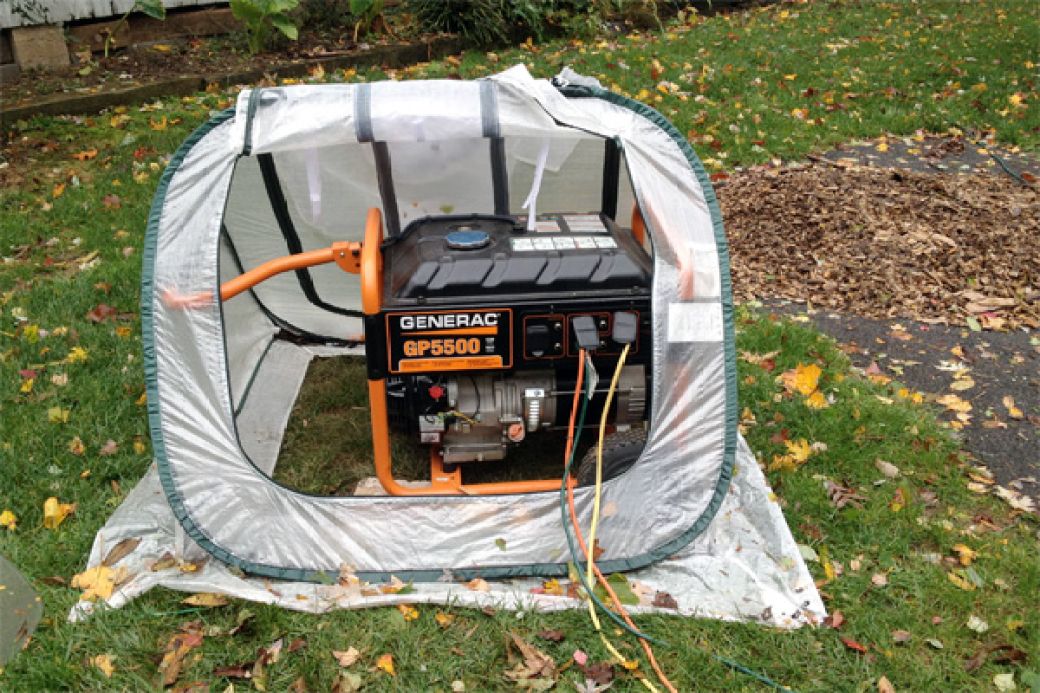In the wake of Hurricane Sandy, portable generators are lifesavers, providing power to home owners in ravaged areas. But portable generators also can kill.
- Carbon monoxide can seep into your house and poison you in your sleep. So only use portables in open areas at least 5 ft. feet away from your home.
- Rain and snow can seep into the generator, causing corrosion and, worse, electrocution. So never operate a portable in rain, snow, or any severe weather.
And there’s the rub: Inclement weather makes you need a portable generator, then officially prevents you from using one. So, what’s the point?
Portable Generators
To deal with this catch-22, I jerry-rigged a shelter for my portable generator to keep it dry after Sandy blew out our power in McLean, Va., and dropped rain for two days afterward. I covered my cherished Generac 5500 with the plastic, portable greenhouse that had been protecting my fall radishes. The greenhouse has flaps and vents for necessary air circulation and easy access to generator outlets.
Problem solved, until the hot exhaust spewing from the muffler melted a hole in the plastic: Man plans; Mother Nature laughs. I won’t be trying this again. Too dangerous.

Luckily, power returned before an entire side of the greenhouse vanished. And I stored my Generac — my second favorite thing in the world — determined to find a better way of using it before the next outage. And in Virginia, I’ve learned, there is always a next outage.
A little Google research turned up all kinds of DIY portable generator shelters, all of which had their drawbacks, like mine:
- Pup tents, which keep the generator dry, but can trap exhaust
- Umbrellas clamped to the generator frame, which provide ventilation, but expose outlets to driving rain
- Shade canopies, which provide circulation and protection, but aren’t designed to stand up to high winds
Then I came across the GenTent — a fiberglass frame clamped onto the generator and topped with heavyweight, vinyl-coated fabric. It looks like an outdoor grill cover, but it protects electrical outlets while allowing air to circulate and fumes and heat to escape.
Inventor Mark Carpenter says his GenTent ($190) was born from his frustration operating his own portable generator during an ice storm that pelted his home in Nottingham, N.H., in 2008.
“It was a really tricky engineering problem,” says Carpenter, a former IT executive who went through five product designs before he invented a cover that could weather gale-force winds. Take a look at the video he made during Hurricane Irene in 2011.
Personally, I’m going to try out the demo GenTent that Carpenter is sending me. And if it works, I’m in. Even though $200 is a lot to spend, anything that lets me use my generator when I need it most is money well spent. I’ll let you know how it goes during the next inevitable power outage that threatens the food in my fridge.
If a $200 tent isn't in your future, Art Aiello of Generac Power Systems says you can operate your generator under a:
- Carport
- Boat canopy with all four sides open
- Tarp overhanging a tree
But never use a generator “inside an enclosed space, including, but not limited to, a shed, garage, home, trailer, or vehicle -- even if doors are left open," Aiello says.
